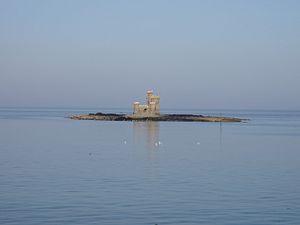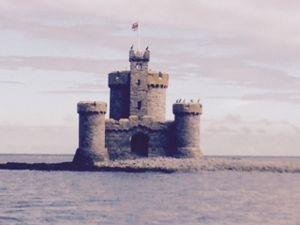St Mary's Isle facts for kids
 |
|
| Coordinates | 54°09′01″N 4°28′07″W / 54.15028°N 4.46861°W |
|---|---|
| Location | Douglas, Isle of Man |
St Mary's Isle is a small rocky reef in Douglas Bay on the Isle of Man. It's also known as Conister Rock or the Tower of Refuge. In the Manx language, it's called Kione y Sker or Creg Voirrey.
This reef is partly underwater, but you can sometimes walk to it at very low tide. It's located near the ferry terminal in Douglas. Part of the rock, called the Conister Shoals, was blasted away in the 1980s. This happened when a new wall was built for the harbour.
Before 1832, the rock belonged to the Quane family. Then, John Quane, who was the Attorney General of the Isle of Man, gave the rock to Sir William Hillary. Sir William was the head of the local Royal National Lifeboat Institution (RNLI) group. He wanted to build the Tower of Refuge there. Since then, the local lifeboat association's president has looked after St Mary's Isle.
Contents
What's in a Name?
The name Conister comes from the Manx words Kione y sker. This means 'head of the reef'.
The St George Rescue
On November 19, 1830, a ship called the St George arrived in Douglas Harbour. This packet steamer carried mail and passengers from Liverpool.
The St George belonged to a company from Liverpool. It was competing with the new Isle of Man Steam Packet Company. After dropping off its passengers and mail, the St George anchored near Conister Rock. It used a strong chain to stay in place.
The night turned stormy with very strong winds. Early on November 20, the wind got even stronger. Around 5 AM, the ship's chain broke. The St George started to drift towards the rocks.
Even though the crew was ready, the ship hit Conister Rock very hard. It quickly filled with water at the front. The ship was now stuck against the most rugged part of the rock.
Lieutenant Tudor, the ship's commander, immediately sent out distress signals. He also ordered the front mast to be cut down. They hoped to make a raft to rescue people when daylight came, but this didn't work.
From his home nearby, Sir William Hillary saw the disaster. He quickly went to the pier to start a rescue. Sir William, along with Lieutenant Robinson, William Corlett, Issac Vondy (his coxswain), and 14 volunteers, set out in a lifeboat.
They tried to reach the St George from the windy side. But the waves were too big. Then, the lifeboat backed in between the St George and the rocks. Lieutenant Tudor warned them it was dangerous, but the lifeboat crew kept going.
The lifeboat started to fill with water and got damaged. Its rudder broke, and six of its ten oars were lost. Worse, Sir William, Corlett, and two other boatmen were washed overboard!
Corlett and the two boatmen were quickly pulled back into the boat. Sir William, who couldn't swim, grabbed a rope. Lieutenant Tudor and Lieutenant Robinson helped him get back on board, but he was badly hurt.
With the lifeboat damaged and oars lost, they couldn't move it easily. They were stuck between the wrecked ship, Conister Rock, and another point of rock.
The crews of both the St George and the lifeboat were in great danger for two hours. Luckily, they found knives and an axe in the boat. They used these to cut away the ropes from the fallen mast.
As the tide rose, the waves grew bigger. They swept over the St George's decks, almost sinking the lifeboat. Everyone made one last effort to escape.
There were 22 crew members on the St George and 18 on the lifeboat. They all managed to get into the lifeboat. It was taking on a lot of water, so they used buckets from the St George to bail it out.
Using the few remaining oars, they pushed off. But the lifeboat hit a low part of the rock, filled with water, and then was washed over it. The people held on to ropes.
They cut the cable, and the sea pushed the lifeboat to the sheltered side of Conister Rock. This saved them from disaster. They could then head towards the shore, about a quarter of a mile away.
Two other boats from the pier met them. Some of the St George's crew moved to the first boat. The second boat, led by Lieutenant Sleigh, got a rope to the lifeboat. It towed the lifeboat safely to the beach. Amazingly, none of the forty men were lost!
A memorial showing this rescue can be seen in the sunken garden on Loch Promenade in Douglas.
Douglas Lifeboat Crew
- Sir William Hillary
- Lieut. Robert Robinson (RN)
- William Corlett (agent for the St. George's Company)
- Issac Vondy (coxswain)
- William Connor
- John Inch
- Thomas Carran
- Thomas Cannell
- William Gill
- George Thompson
- Henry Clague
- Robert Kewley
- Richard Harvey
- Philip Cottier
- John Callow
- Richard Cowell
- One unnamed person
SS St. George Crew
- Lieut. John Tudor (RN) (Commander)
- Joseph Owen (Second Officer)
- 20 other crew members
In 1833, the owners of the St George gave Sir William £50. This money was given to the lifeboat crew as a thank you.
The Tower of Refuge
The Tower of Refuge was built on the reef in 1832. It was ordered by Sir William Hillary, who helped start the Royal National Lifeboat Institution (RNLI). Many ships had crashed on this partly submerged rock. Sir William wanted a safe place for survivors to wait until help arrived.
Sir William paid a lot of the building costs himself. He also got many people to donate money. The person who owned the small island agreed to let them build the refuge. After it was built, the tower was filled with supplies like bread and fresh water for shipwrecked people. It even had a bell to call for help.
The refuge was designed to look like a castle. A local architect named John Welch designed it. He also designed other important buildings on the Isle of Man.
The famous poet William Wordsworth wrote a poem about the tower:
COMPOSED OR SUGGESTED DURING A TOUR IN THE SUMMER OF 1833
XV ON ENTERING DOUGLAS BAY, ISLE OF MAN
- "Dignum laude virum Musa vetat mori."
- THE feudal Keep, the bastions of Cohorn,
- Even when they rose to check or to repel
- Tides of aggressive war, oft served as well
- Greedy ambition, armed to treat with scorn
- Just limits; but yon Tower, whose smiles adorn
- This perilous bay, stands clear of all offence;
- Blest work it is of love and innocence,
- A Tower of refuge built for the else forlorn.
- Spare it, ye waves, and lift the mariner,
- Struggling for life, into its saving arms!
- Spare, too, the human helpers! Do they stir
- 'Mid your fierce shock like men afraid to die?
- No; their dread service nerves the heart it warms,
- And they are led by noble HILLARY.
NOTE
14 'And they are led by noble Hillary.'
The TOWER OF REFUGE, an ornament to Douglas Bay, was erected chiefly through the humanity and zeal of Sir William Hillary; and he also was the founder of the lifeboat establishment at that place; by which, under his superintendence, and often by his exertions at the imminent hazard of his own life, many seamen and passengers have been saved.
Images for kids
Other Uses
Conister Trust, a financial company on the Isle of Man, was named after Conister Rock. It was founded in 1935.





